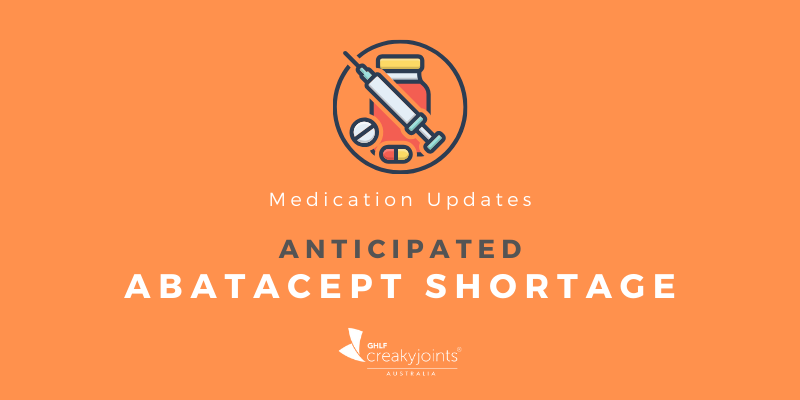Rheumatoid Arthritis Medications
There are many medications available for rheumatoid arthritis (RA). We have outlined the most common RA medications available in Australia.
Analgesics (Paracetamol, Aspirin, Ibuprofen, Codeine, Tramadol®, Norspan®)
Analgesics (also simply known as pain-killers) are a broad class of medications used to treat the symptoms of pain. They work by dulling or blocking pain signals to the brain, however, they do not change the cause of the pain. They usually come in the form of oral tablets or capsules that can be taken as needed, or as a regular dose (preferably under medical supervision) up to a maximum daily limit.
Common analgesics include paracetamol (Panadol®, Panamax®), ibuprofen (Nurofen®, Brufen®, Nuromol®) and aspirin (Disprin®, Aspro Clear®). These are available over the counter (OTC) through supermarkets or pharmacies.
Some analgesics also have anti-inflammatory properties and are referred to as nonsteroidal anti-inflammatory drugs (NSAIDs). Aspirin and ibuprofen are also classed as NSAIDs, but paracetamol is not, as it has limited anti-inflammatory benefits.
Paracetamol and aspirin can be combined with various other drugs, such as some opioid products (including Panadeine Forte®) or NSAIDs to increase pain relief or reduce inflammation. Some of these are available over the counter, but many are only available on prescription (including all products containing codeine), due to their strength and increased risks.
NSAIDs (Nurofen®, Voltaren®, Celebrex®, Mobic®)
Nonsteroidal anti-inflammatory drugs, or NSAIDs (pronounced “en-seds” or “en-sayeds”), are the most commonly used treatments for inflammation and pain symptoms. While some of your other arthritis medications are designed to slow or stop your inflammation at the source in your body’s immune system and, therefore, ease joint swelling and pain, you may also take NSAIDs to help manage your symptoms.
NSAIDs are used for inflammatory conditions, such as osteoarthritis and rheumatoid arthritis, and also for non-inflammatory conditions like migraine and period pain.
They are generally safe to use for minor flares of pain, but they do have many possible side effects if you take them for a long time or in high doses.
Common NSAIDs include:
- Aspirin (Disprin®, Aspro Clear®)
- Ibuprofen (Nurofen®, Brufen®, Nuromol®)
- Diclofenac sodium (Voltaren®, Solaraze®, Fenac®)
- Celecoxib (Celebrex®)
- Meloxicam (Mobic®)
The NSAIDs available over the counter generally have lower doses for mild pain. For stronger pain, there are higher doses of NSAIDs available by prescription. Some NSAIDs are only available by prescription.
Don’t take an over-the-counter NSAID if you’re already taking a prescription NSAID, and check with your doctor or pharmacist before using a topical NSAID (generally used for local inflammation sites). If you are already using another form of NSAID, you could easily take too much medicine and put yourself at high risk for side effects like stomach pain or bleeding.
You can buy generic or “store brand” versions of most of these medications.
No single NSAID is more effective than others. It’s up to you and your rheumatologist to decide which one may be right for you to take for your arthritis pain.
Glucocorticoids/Cortisone (Prednisolone, Panafcortelone®, Predsone®, Predsolone®, Solone®)
Glucocorticoids are medicines used to reduce inflammation throughout the body. They may also be called cortisone, corticosteroids or even “steroids” for short. The most commonly prescribed glucocorticoid in Australia is prednisolone (Panafcortelone®, Predsone®, Predsolone®, Solone®).
They’re often used as a bridging therapy while you’re waiting for your DMARD or biologics to kick in. They can also be used if you have a flare and need quick symptom relief.
Sometimes, none of your other medications reduce your symptoms enough, so you add a low dose of steroids. As steroids can have serious side effects at high doses or when taken for an extended period of time, it’s best to take the lowest possible dose you need to ease your symptoms. You should never suddenly stop your steroids if you have been taking them for longer than two weeks unless you have tapered to a low enough dose as directed by your doctor.
Conventional Synthetic DMARDS/DMARDs (Methotrexate, Methoblastin®, Leflunomide, Arava®, Hydroxychloroquine, Plaquenil®, Sulphasalazine, Salazopyrin®)
DMARDs (pronounced ‘dee-mard’s) are the most widely used and studied drugs used as therapy for autoimmune arthritis. DMARD stands for disease-modifying antirheumatic drug.
A DMARD is a medication that slows down the progression of your disease. Other than glucocorticoids (steroids), conventional synthetic DMARDs have been on the market the longest and have the most evidence to support their use.
The most commonly used DMARD for autoimmune arthritis are those from the csDMARD family, especially methotrexate (Methoblastin®, Trexject®). This category is often simply referred to as “DMARDs” although it is really a sub-classification of the whole DMARD class of medications.
Leflunomide (Arava®) hydroxychloroquine (Plaquenil®) and sulphasalazine (Salazopyrin®) are often used for mild forms of autoimmune arthritis and other conditions. They are thought to have fewer possible side effects. Less common side effects include allergic reactions and development of other immune system disorders.
Other csDMARDs occasionally used for RA include gold injections, azathioprine (Azapin®, Imuran®, Thioprine®) and cyclophosphamide (Cycloblastin® Endoxan®).
DMARDs can be divided into different classifications:
- Conventional synthetic DMARDs (csDMARDs)
- Targeted synthetic DMARDs (tsDMARDs): including JAK inhibitors
- Biologic DMARDs (bDMARDs): including biosimilars
All DMARDs suppress the immune system, so they can make you more prone to contracting and fighting off infections.
Combination Therapy
Everyone is different. In some cases, one csDMARD might not work by itself or at all. In those cases, a doctor will discuss the following with you:
- Double therapy: Double therapy is the use of two different medications, usually methotrexate and another csDMARD, such as leflunomide, sulphasalazine or hydroxychloroquine.
- Triple therapy: Triple therapy uses three medications instead of two. Monitoring for both triple and double therapy is similar to monitoring for csDMARD monotherapy. Closer monitoring, initially, may be warranted depending on the combination of medications.
Sometimes, combination therapy will include the use of a biologic or tsDMARD.
Evidence shows that more aggressive treatments are associated with better control of the disease, slower radiological progression (meaning that your X-rays or imaging scans show that your joint damage is slowing down) and improved functional outcomes. There are many combinations of medications, although there is uncertainty around which is the most effective.
It’s up to your doctor to decide which medication combination is best for you. In general, combination therapy is well tolerated but needs to be monitored closely for any increased side effects.
Targeted Synthetic DMARDs/JAK Inhibitors (Tofacitinib, Xeljanz®, Baricitinib, Olumiant®)
As their name implies, targeted synthetic DMARDs (tsDMARDs) are also made from synthetic chemical compounds with small molecules. They are not biologics, but they do target specific parts of the immune system, as opposed to conventional synthetic DMARDs, which have a dampening effect on the whole immune system.
Targeted synthetic DMARDs can be prescribed for some types of autoimmune arthritis. They are grouped with biologics to streamline distribution through the Pharmaceutical Benefits Scheme (PBS) in Australia. Like biologics, a tsDMARD will only be prescribed if your condition is active and csDMARD treatment is unsuccessful or inadequate. Access will only be continued if this treatment helps your condition.
They are administered as daily tablets which pass through the digestive system and work from within the immune cells. This makes them a good option for many people who prefer the convenience of a daily oral tablet over a regular injection or infusion of a biologic.
To date, janus kinase (JAK) inhibitors are the only sub-classification of targeted synthetic DMARDs available in Australia, although there are others being researched globally.
JAK inhibitors work by inhibiting the activity of one or more of the Janus kinase family of enzymes JAK1, JAK2, JAK3 and tyrosine kinase, which are parts of the immune system that can be related to RA symptoms. Possible side effects of JAK inhibitors are similar to those of other DMARD treatments.
There are currently two types of JAK inhibitors available in Australia.
- Tofacitinib (Xeljanz®) targets JAK1 and JAK3. It has been available here for several years and has been increasingly prescribed by rheumatologists as an alternative to biologics.
- Baricitinib (Olumiant®) targets JAK1 and JAK2. It was made available to Australian patients in 2018 to provide an additional option for those who prefer a daily tablet to a biologic medication.
As each JAK inhibitor targets a different part of the immune system you may find one to be more effective than the other. Your rheumatologist may even prescribe a JAK inhibitor before you try a biologic if he or she thinks it’s the best option for you.
JAK inhibitors work fairly quickly compared to some other DMARD medications and you may notice your symptoms start to subside within the first month of treatment. However, it can take several more months to take full effect. Your rheumatologist will monitor your treatment closely with you to determine its effectiveness.
Biologic DMARDs
Biologic DMARDs (also called bDMARDs or “biologics”) are a different class of DMARDs and are grown from biologically-sourced cells. As their molecular structures are much larger and more complex than synthetic medications (including csDMARDs and NSAIDs) they cannot be processed through the digestive system. Instead, they are injected or infused into the bloodstream.
You may be able to give yourself this medication, via subcutaneous injections, at home (known as “self-injection”) or receive it via an infusion in a hospital or authorised infusion centre. You and your doctor can decide if an infusion is the right option for you.
There are two main classes of biologic DMARDs; each targets slightly different parts of the immune system:
- TNFi biologics
- Non-TNFi biologics
TNFi Biologics (Adalimumab, Humira®, Certolizumab, Cimzia®, Etanercept, Enbrel®, Golimumab, Simponi®, Infliximab, Remicade®)
TNFi biologic medications work by targeting a protein called tumour necrosis factor (TNF) and blocking it at the source. TNF acts as a messenger that sends signals through your body, eventually leading to inflammation that causes swelling, pain, and stiffness. By inhibiting, or stopping, TNF, these medications can cool down your immune response and reduce inflammation. That’s why they’re often called TNF inhibitors (or TNFi).
Your rheumatologist may prescribe TNFi biologics if previous DMARD monotherapy was ineffective. Personal considerations such as comorbidities and side effects may make TNFi therapy (often with the addition of methotrexate) the best option.
For individuals with specific types of inflammatory (or autoimmune) arthritis, TNFi biologics could be an addition to your DMARD monotherapy or double therapy or used alone. Your rheumatologist will determine which option is best for you based on your personal medical history.
Some common TNFi biologics are:
- Adalimumab (Humira®)
- Certolizumab pegol (Cimzia®)
- Etanercept (Enbrel®, Brenzys®, Erelzi®)
- Golimumab (Simponi®)
- Infliximab (Remicade®, Jaximab®, Inflectra®, Remsima®, Emisima®, Flixceli®, Renflexis®)
Non-TNFi Biologics (Abatacept, Orencia®, Rituximab, MabThera®, Tocilizumab, Actemra®)
Non-TNFi biologics are a class of biologics that target the immune system in different ways from TNFi medications. They interact with different kinds of white blood cells, such as T-cells or B-cells, in your immune system. They can also block chemicals called cytokines that cause inflammation.
White blood cells and cytokines are made by your immune system to fight off infection, however, in inflammatory arthritis (or autoimmune arthritis), they may be out of control and lead to inflammation. Non-TNFi biologics can suppress your immune system, ease inflammation, slow or stop disease progression and ease your symptoms.
If disease activity remains moderate or high despite use of DMARD therapy, biologics that target the immune system in different ways from TNFi biologics or targeted synthetic DMARDs may be used, depending on the medication and your individual health circumstances.
Some common biologics that work differently than TNFi biologics include:
- Abatacept (Orencia®, Orencia Clickject®)
- Rituximab (MabThera®)
- Tocilizumab (Actemra®)
Biosimilars (Inflectra®, Renflexis®, Brenzys®, Erelzi®)
There’s another medication option that is now available in Australia to treat some forms of inflammatory arthritis — biosimilar medications. You may have seen this term in the news, or even heard your doctor or nurses mention it. As original biologic brand patents expire, very close copies of these (known as biosimilars) are now coming onto the market. Biosimilars work the same way as biologics and have the same indications, however, the approval processes currently differ.
Biosimilars are taken in the same way as their reference medication and have the same possible side effects, contraindications and monitoring tests. All biosimilars have to meet the same standards of safety and efficacy as any other prescription medication approved by the Therapeutic Goods Association (TGA).
The biosimilars for inflammatory arthritis that are currently subsidised in Australia through the PBS are:
- Infliximab (Inflectra®, Remsima®, Emisima®, Flixceli®, Renflexis®)
- Etanercept (Brenzys®, Erelzi®)





